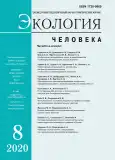POST-EXTRACTION REGENERATION OF JAW BONE SANOGENESIS MODEL
- Authors: Muzykin M.I.1, Iordanishvili A.K.1,2
-
Affiliations:
- S. M. Kirov Military Medical Academy
- International Academy of Ecology, Human and Nature Safety Sciences
- Issue: Vol 27, No 8 (2020)
- Pages: 40-48
- Section: Articles
- URL: https://journals.rcsi.science/1728-0869/article/view/43476
- DOI: https://doi.org/10.33396/1728-0869-2020-8-40-48
- ID: 43476
Cite item
Full Text
Abstract
Full Text
##article.viewOnOriginalSite##About the authors
M. I. Muzykin
S. M. Kirov Military Medical Academy
Email: Muzikinm@gmail.com
кандидат медицинских наук, докторант кафедры челюстно-лицевой хирургии и хирургической стоматологии Seint Petersburg, Russia
A. K. Iordanishvili
S. M. Kirov Military Medical Academy; International Academy of Ecology, Human and Nature Safety SciencesSeint Petersburg, Russia
References
- Ахмедов А. А., Толлибоев Д. М. Современная экология: структура экологической области знаний // Школа Науки. 2019. № 7 (18). С. 39-42.
- Васильченко Г. А. Анатомические предпосылки затруднённого прорезывания нижних третьих моляров: автореф. дис.. канд. мед. наук. Санкт-Петербург, 2012. 34 с.
- Годунова И. В., Щипский А. В., Серова Н. С. Роль лучевых методов исследования в оценке восстановления костной ткани после проведения цистотомии у пациентов с обширными кистами челюстей // Russian El. J. Radiology. 2016. № 6 С. 22-28.
- Голиков В. А. Проблемы моделирования адаптационных процессов в организме человека // Актуальные проблемы транспортной медицины. 2005. № 2. С. 37-41.
- Горбатова М. А., Гржибовский А. М., Горбатова Л. Н., Зинченко Г. А., Владимирова А. С. Алиментарные факторы риска стоматологического здоровья и кариес зубов у 15-летних подростков Архангельской области // Клиническая стоматология. 2019. № 1 (89). С. 4-10.
- Иорданишвили А. К. Возрастные физиологические и патофизиологические особенности жевательного аппарата взрослого человека // Успехи геронтологии. 2019. Т. 32, № 5. С. 824-828.
- Калашников И. Н., Щербатюк Т. Г. Основы медицинской экологии и экологии человека. Нижний Новгород, 2018. С. 30-42.
- Лепехова С. А., Судаков Н. П., Жаркая А. В. Моделирование патологических процессов в эксперименте - первый шаг в трансляционную медицину // Актуальные вопросы трансляционной медицины. Иркутск, 2017. С. 6-9.
- Музыкин М. И., Иорданишвили А. К., Лосев Ф. Ф. Остео-мускулярный физиологический рефлекс жевательного аппарата и его характеристика // Пародонтология. 2017. Т. 22, № 4 (85). С. 9-13.
- Неумывакин И. П., Неумывакина А. С. Эндоэкология здоровья. СПб., 2019. С. 24-27.
- Поплавский Д. В., Музыкин М. И., Иорданишвили А. К. Методы костной пластики в амбулаторных стоматологических учреждениях // Институт стоматологии. 2015. № 4 (69). С. 32-34.
- Рыжак Г. А., Иорданишвили А. К., Музыкин М. И., Никитенко В. В. Факторы риска в патогенезе одонтогенного периостита челюстей у взрослых людей в различных возрастных группах // Medline.ru. Российский биомедицинский журнал. 2012. Т. 13, № 3. С. 641-649. URL: http://www.medline.ru/public/art/tom13/art53.html (дата обращения: 12.01.2020).
- Титов В. Н. Теории биологических функций и ее применение при выяснении патогенеза распространенных заболеваний человека // Успехи современной биологии. 2008. Т. 128, № 5. С. 435-452.
- Устинова О. И. Составляющие экологической готовности организма человека к приспособлению (обзор литературы) // Научная дискуссия: вопросы медицины. 2016. № 11 (41). С. 79-88.
- Цыган В. Н. Патофизиология. Клиническая патофизиология. СПб, 2018. Т. 1. С. 38-42.
- Чащин В. П., Гудков А. Б., Попова О. Н., Одланд И. О., Ковшов А. А. Характеристика основных факторов риска нарушений здоровья населения, проживающего на территориях активного природопользования в Арктике // Экология человека. 2014. № 1. С. 3-12.
- Araujo M. G., Silva C. O., Souza A. B. Socket healing with and without immediate implantplacement // Periodontology 2000. 2019. Vol. 79. Р 168-177.
- Bradbury P., Wu H., Choi J. U., Rowan A. E., Zhang H. Modeling the Impact of Microgravity at the Cellular Level: Implications for Human Disease // Front Cell Dev. Biol. 2020. N 21. Р 93-96
- Casteren A., Strait D. S., Swain M. V. Hard plant tissues do not contribute meaningfully to dental microwear: evolutionary implications // Sci. Rep. 2020. N 10 P. 582-584.
- Chappuis, V., Araujo M. G., BuserD. Clinical relevance of dimensional bone and soft tissue alterations post-extraction in esthetic sites // Periodontology 2000. 2017. Vol. 23, N 7. Р 73-83.
- Darcy J. L., Washburne A. D., Robeson M. S. A phylogenetic model for the recruitment of species into microbial communities and application to studies of the human microbiome // ISME J. 19.02.2020 Doi: 10.1038/ s41396-020-0613-7). URL: https://www.nature.com/articles/ s41396-020-0613-7.
- Oh S. J., You J. S., Kim S. G. Clinical and histomorphometric evaluation of decompression followed by enucleation in the treatment of odontogenic keratocyst // Journal of dental scienses. 2018. N 13. P. 329-333.
- Marchesan J. T., Girnary M. S., Moss K. Role of inflammasomes in the pathogenesis of periodontal disease and therapeutics // Periodontol 2000. 2020. N 82 (1). P. 93-114.
- Neumayer S. The Tissue Master Concept (TMC): innovations for alveolar ridge preservation // Int. J. Esthet. Dent. 2017. Vol. 12. P. 246-257.
- Ohashi N., Nonami J., Kodaira M., Yoshida K., Sekijima Y. Taste disorder in facial onset sensory and motor neuronopathy: a case report // BMC Neurol. 2020. N 20. P. 71-75.
- Proctor D. M., Shelef K. M., Gonzalez A., Davis C. L. Microbial biogeography and ecology of the mouth and implications for periodontal diseases // Periodontol. 2000. N 82 (1). P. 26-41.
- Rezzani R., Nardo L., Favero G., Peroni M., Rodella L. F. Thymus and aging: morphological, radiological, and functional overview // Age (Dordr.). 2014. N 36. P. 313-351.
- Thapa P., Farber D. L. The Role of the Thymus in the Immune Response // Thorac. Surg. Clin. 2019. N 29 (2). P. 123-131.
- Trombelli, L. Modeling and remodeling of human extraction sockets // Journal of Clinical Periodontology. 2008. Vol. 35, N 7. Р. 630-639.
- Wells M. L., Karlson B., Wulff A., Kudela R., Trick C. Future HAB science: Directions and challenges in a changing climate // Harmful Algae 2020. N 91. P. 1-18. Doi: 10.1016/j. hal.2019.101632.
Supplementary files







